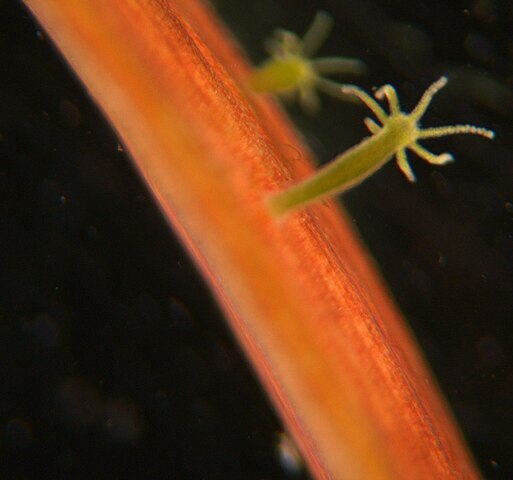
What is the immortal hydra? It is a tiny, freshwater creature that doesn’t appear to age.
Hydra are very small invertebrates that live in freshwater ponds, lakes, streams, and rivers. They are about 10 mm long and have a tubular body. At one end of their body they have a mouth surrounded by twelve thin tentacles. They prey on even tinier crustaceans called daphnia and cyclops. They have stinging cells at the end of each one of their tentacles that contain a coiled thread with a neurotoxin on it. When prey touches the stinging cell, the thread is fired out and the neurotoxin paralyzes the prey. Other tentacles move the prey towards the mouth, but the hydra doesn’t have a mouth with muscles in the same way that we do. They have specialized cells at the top of their head that can move around to open and close the mouth. Once inside, the prey is digested. Hydra are very simple and they have a simple neural net of nerves, but they are able to survive very effectively.
The tiny animal is called a hydra after the Greek mythological water monster that had many heads and after each one was cut off, another grew in its place. The hydra we are talking about can do pretty much the same thing. If you cut the top of a hydra off, it will regrow. If you cut the hydra into pieces, each piece will grow into a new hydra. On top of that, hydra are able to regenerate themselves completely, so they never age. That is not to say that they can’t die. Hydra can be eaten by fish, starved, or killed in many other ways. They can live forever if they are not killed in another way. They are particularly sensitive to pollution.
So, how do they do it? Hydra have stem cells in their bodies that can be directed to reproduce any of their cells. If they lose a head or if they lose a tentacle, they can direct the stem cells to reproduce those exact parts. They can also do the same thing when they reproduce. Hydra generally reproduce asexually and they do it by basically growing a clone of themselves. The stem cells in their bodies form a bud that grows into a miniature hydra before it breaks away from the original hydra and makes its own way.
People are not sure how the hydra can do what it does, but experiments are underway. Research has shown that different genes are activated when the hydra is regrowing a part of its own body and when it is growing a clone. The hydra is able to tell its stem cells not just what kind of head to grow, but whether it is its own head or the head of a new clone. The process also runs at a different pace. When building a clone, the stem cells take about 72 hours, but when regenerating a head, they can do it in 48 hours. They not only know what they are building, they appear to know that one thing is more important than the other.
Other research has shown that there are three different types of stem cells that are needed to regrow a part of the hydra’s body. These are ectodermal epitheliomuscular cells, endodermal epitheliomuscular cells, and interstitial stem cells. While the researchers don’t know exactly how the hydra can trigger their stem cells to make new parts of themselves, they noticed that all three of these have one protein in common. That protein is FoxO. This interested the researchers because humans that live past 100 years also usually possess variants of the FoxO protein. It must have something to do with aging and with how hydra can live forever.
We can learn a lot from the hydra, but it won’t necessarily apply to us because we are far more complex beings with a lot more different kinds of cells. FoxO has given the hydra immortality, but if it evolved into something more complex, the gene probably wouldn’t be able to work as effectively. In our bodies, the FoxO proteins have evolved to cover processes, such as oxidative stress, metabolism, cell cycle regulation, immunity, inflation, and a whole host of other things. Just because this gene is present in people who live over 100, doesn’t mean that inserting the gene into people will make them live past 100. And this is what I learned today.
Image By Coveredinsevindust at English Wikipedia, CC BY-SA 3.0, https://commons.wikimedia.org/w/index.php?curid=5273405
Sources
https://www.pnas.org/doi/10.1073/pnas.2210439120
https://www.dw.com/en/anti-aging-secret-biodiversity-regeneration/a-62566297
https://www.livescience.com/how-hydras-regrow-heads-map
https://karger.com/ger/article/61/6/515/148076/FOXO3-A-Major-Gene-for-Human-Longevity-A-Mini
